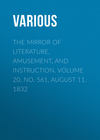Читать книгу: «The Mirror of Literature, Amusement, and Instruction. Volume 20, No. 561, August 11, 1832», страница 3
MADAME DE STAËL
(From Lady Blessington's Conversations with Lord Byron.)
Talking of literary women, Lord Byron said that Madame de Staël was certainly the cleverest, though not the most agreeable woman he had ever known. "She declaimed to you instead of conversing with you," said he, "never pausing except to take breath; and if during that interval a rejoinder was put in, it was evident that she did not attend to it, as she resumed the thread of her discourse as though it had not been interrupted." This observation from Byron was amusing enough, as we had all made nearly the same observation on him, with the exception that he listened to, and noticed, any answer made to his reflections. "Madame de Staël," continued Byron, was very eloquent when her imagination warmed, (and a very little excited it;) her powers of imagination were much stronger than her reasoning ones, perhaps owing to their being much more frequently exercised; her language was recondite, but redundant, and though always flowery, and often brilliant there was an obscurity that left the impression that she did not perfectly understand what she endeavoured to render intelligible to others. She was always losing herself in philosophical disquisition, and once she got entangled in the mazes of the labyrinth of metaphysics; she had no clue by which she could guide her path—the imagination that led her into her difficulties, could not get her out of them; the want of a mathematical education, which might have served as a ballast to steady and help her into the port of reason, was always visible, and though she had great tact in concealing her defeat, and covering a retreat, a tolerable logician must have always discovered the scrapes she got into. Poor dear Madame de Staël, I shall never forget seeing her one day, at table with a large party, when the busk (I believe you ladies call it) of her corset forced its way through the top of the corset, and would not descend though pushed by all the force of both hands of the wearer, who became crimson from the operation. After fruitless efforts, she turned in despair to the valet de chambre behind her chair, and requested him to draw it out, which could only be done by his passing his hand from behind over her shoulder, and across her chest, when, with a desperate effort, he unsheathed the busk. Had you seen the faces of some of the English ladies of the party, you would have been like me, almost convulsed; while Madame remained perfectly unconscious that she had committed any solecism on la décence Anglaise. Poor Madame de Staël verified the truth of the lines—
"Qui de son sexe n'a pas l'esprit,
De son sexe a tout le malheur."
She thought like a man, but, alas! she felt like a woman; as witness the episode in her life with Monsieur Rocca, which she dared not avow, (I mean her marriage with him,) because she was more jealous of her reputation as a writer than a woman, and the faiblesse de coeur, this alliance proved she had not courage to affiche.—New Monthly Mag.
THE TOPOGRAPHER
REMARKABLE CAVES AT CRAVEN, IN YORKSHIRE
The village of Malham is situated in a deep and verdant bottom, defective only in wood, at the union of two narrow valleys, respectively terminated at the distance of a mile by the Cove and Gordale. The first of these is an immense crag of limestone, 286 feet high, stretched in the shape of the segment of a large circle, across the whole valley, and forming a termination at once so august and tremendous, that the imagination can scarcely figure any form or scale of rock within the bounds of probability that shall go beyond it. The approach to this place, before the invention of machinery, was solitary and characteristic. It is now polluted by one of those manufactories, of which it would he trifling to complain as nuisances only in the eye of taste. Yet there are streams sufficiently copious, and valleys sufficiently deep, which man can neither mend nor spoil. These might be abandoned to such deformed monsters without regret; but who that has either taste or eyes can endure them, when combined with such scenery as the environs of Malham, or the Banks of the Wharf.
Coarse complexions
And cheeks of every grain will serve to ply
The sampler, and to teaze the housewife's wool;
What need a vermeil, tinctured lip for that,
Love-darting eyes, and tresses like the morn?
The approach to Gordale on the east side of the village, happily remains what nature left it, a stony and desolate valley, without a single object to divert the eye from the scene before it. This is a solid mass of limestone, of perhaps equal height with the Cove, cleft asunder by some great convulsion of nature, and opening its "ponderous and marble jaws" on the right and left. The sensation of horror on approaching it is increased by the projection of either side from its base, so that the two connivant rocks, though considerably distant at the bottom, admit only a narrow line of daylight from above. At the very entrance you turn a little to the right, and are struck by a yawning mouth in the face of the opposite crag, whence the torrent pent up beyond, suddenly forced a passage, within the memory of man, which at every swell continues to spout out one of the boldest and most beautiful cataracts that can be conceived.
Wherever a cleft in the rock, or a lodgment of earth appears, the yew-tree, indigenous in such situations, contrasts its deep and glossy green with the pale grey of the limestone; but the goat, the old adventurous inhabitant of situations, inaccessible to every other quadruped, has been lately banished from the sides of Gordale. But the wonders of this place are not confined to its surface. In mining for lapis calaminaris, two caverns have been discovered near the Tarn, which though of no easy access, will reward the enterprising visitant, not by the amplitude of their dimensions, in which they are exceeded by several in Craven, but by that rich and elaborate finishing which in the works of nature, as well as of art, is always required to give an interest to diminutive objects. The first of these resembles a small rotunda, not more than six yards in diameter, and five or six in height, but clothed with fleecy incrustations, from which depend stalactites of various depth, and tinged with various hue, from the faintest yellow to saffron. The lapidescent drops distilling from these through a long course of ages, have gradually raised the floor of the cavern, so as to render it difficult to pass between the edges of the new surface and the circumference of the cavern.
Beyond is a second excavation about fourteen yards long: ten in width, where broadest, and eight in height; proportions which an architect would have chosen. At the highest extremity of this appears a recess formed entirely of petrified matter, around which the irregular projections of native rock are covered with an incrustation white as snow; and in many parts appear stalactites suspended from point to point, like light festoons of ice, which, if struck, return all the notes of musical glasses. In the midst of this recess arises from a pedestal, clear almost as glass, an amber altar. Beneath, but still in the roof of the cavern, is another circular excavation resembling an immense helmet, which seems to be lined with rich satin, and is fringed with rows of yellow stalactite about the edges. Those who suffer their imaginations to wanton in the scenes of subterranean demonology, may here discover the cabinet of the "Swart Faery of the Mine," while the sober geologist will find matter of rational and curious speculation; he will detect nature herself at work on a process uniformly advancing; so that by piercing the perpendicular depth of the incrustation on the floor of the first cavern, and by comparing with accuracy the additional laminae, which in a few years will be superinduced, he may ascertain with tolerable exactness, the period which has elapsed since those mighty convulsions by which these caverns have been produced.—Whitaker's History of Craven.
SELECT BIBLIOGRAPHY
M. Chaptal

M. Chaptal
M. Chaptal, the celebrated chemist, born at Montpellier in 1755, died a few days since at Paris, in his 77th year. He studied medicine and natural philosophy when very young, and under promising patronage. Before the Revolution he published some valuable works, and formed two or three chemical establishments, and for his successful labours the King had given him the order of St Michael. When the Revolution began, M. Chaptal headed the insurgents at Montpellier, who took possession of the citadel in 1791.
The reputation of Chaptal as a chemist being well established, he was called to Paris in 1793, by the committee of public safety, to be consulted relative to the making of gunpowder and the production of saltpetre. It must be in the memory of all those who recollect the history of the first years of the French Revolution, that the want of saltpetre, the principal ingredient in gunpowder, had nearly put an end to the war; and as France had shut the ports of all nations against herself, no other resource remained but to produce the saltpetre at home. Before Chaptal was sent for, a manufactory, for this purpose, had been established at Grenelles, near Paris; but it was insufficient for the immense demand. Chaptal soon, by his skill and activity, so improved this establishment, that it supplied all that was wanted, and this at a time when France had about 1,400,000 soldiers.3
Chaptal returned to Montpellier in 1794, and soon obtained a place in the administration of the department of Herault, and a professorship of chemistry in the university of Montpellier, which the Directory created expressly as a reward for his services. In 1798, Chaptal revisited Paris, and aided the Revolution by which, in 1799, Buonaparte became First Consul. In the following year Chaptal was made Minister of the Interior, in which important office he imparted new energy to all the manufacturing establishments of France, as well as founded many public schools upon improved systems of education. In 1804 he was dismissed from the Ministry for his refusing to sanction a report stating sugar from beet-root to be superior to that from the cane.4
Chaptal now retired from political life, and established a chemical manufactory in the neighbourhood of Paris; but he was soon after chosen a member of the Conservative Senate, and made grand officer of the Legion of Honour. In 1806, he was present at the placing of the trophied column in the Place Vendome, to commemorate the battle of Austerlitz. Chaptal was soon after made a Count, and received the grand cross of the Legion of Honour.
In 1813, when the Allies began to approach the French frontiers, Chaptal was dispatched to support the falling power of Napoleon; he failed to do so; and when the Austrians approached the capital, he retired to Clermont, but after the taking of Paris he hastened to the city. He was made a member of the Academy of Sciences upon its re-organization.
Upon the return of Napoleon from Elba, he named Chaptal director-general of manufactures and commerce, and immediately after minister of state, in which latter capacity he pronounced, in the name of all the ministers, a very flattering address to Napoleon. At the restoration of the Bourbons, Chaptal again retired into private life, and continued to enjoy the society of a large circle of literary and scientific friends till his death.
Upon the application of chemistry to the arts of life, Chaptal is considered to have been the most distinguished writer of his time. His works are, Conspectus Physiologicus de Fontibus differentiarum relat. ad Scientias, 1777; Analytical Table of a Course of Chemistry delivered at Montpellier, 1783; Elements of Chemistry; Treatise on Saltpetre and Tar; a Table of the principal Earthy Salts and Substances; an Essay on perfectioning the Chemical Art in France; a Theoretical and Practical Treatise on the Cultivation of the Vine; the Art of making Wines, &c.; the Art of Making, Managing, and Perfectioning Wines, a work which has been productive of great improvement in the wines of many districts in France; the Art of Dyeing Cotton Red; Chemistry applied to the Arts; the Chemical Principles of the Arts of Dyeing and Scouring. M. Chaptal has also furnished many excellent articles to the Annals of Chemistry, and the Dictionary of Agriculture. Among his miscellaneous productions, a paper on Geological Changes is entitled to special mention as one of the most beautiful compositions of its class.





















